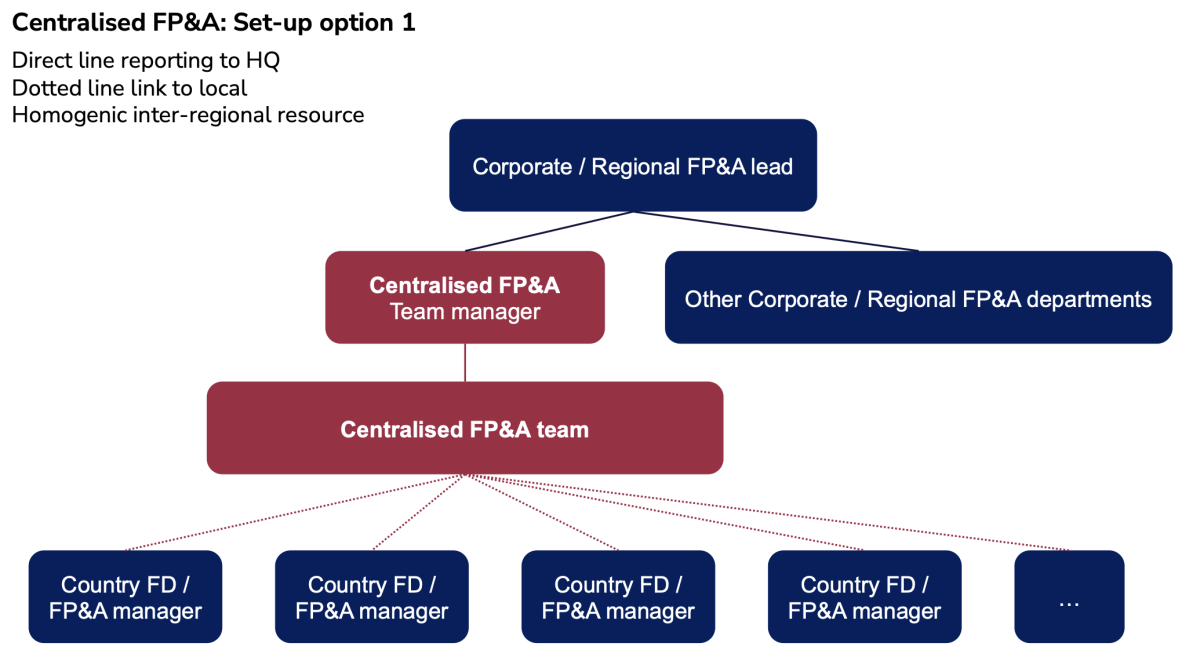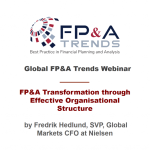Balancing centralised and decentralised FP&A models is key to improving efficiency, collaboration and business agility —...

Introduction: Why Centralise FP&A?
The optimisation and efficiency of back office functions are regularly on the agenda of companies, and there are many different ways to achieve these.
Some of the most used are related not only to process automation, resource allocation, streamlining of data flows, and leveraging modern technologies but also to centralising some selective areas.
In this article, I would like to explore the complexities, advantages, and risks associated with the centralisation of the FP&A function, share my thoughts about the process for successful implementation and a vision for the possible future FP&A centralised model.
The optimal FP&A function is expected to be the one that seamlessly integrates advanced technologies, standardised processes, and skilled professionals to provide strategic insights and support decision-making. Considering the need to stay close to business, FP&A usually stays outside of the centralisation radar.
One point here to note: While I think that the complete FP&A centralisation could contain some risks for the business, I am sure there are multiple areas and activities in the FP&A set up that can be centralised.
With this, jumping ahead with a conclusion before sharing the details, my advice would be to go for the Hybrid FP&A Model, which combines centralised and decentralised elements and can balance the benefits of centralisation with the need for local business support.
Key Criteria: Maturity and FP&A Resource Profiles
All in all, there are some important criteria to consider before starting the FP&A centralisation discussions. These include two main points to review:
- The maturity of the FP&A organisation
- The validation of the FP&A resources profiles
FP&A Maturity Levels
While it is easier to centralise the function at the leading stage of maturity, especially in the areas of processes, data analytics, and technology, there could be many complexities if the organisation is at the developing or intermediate stage.
The leading stage of maturity includes integrated processes, agile planning possibilities, modern technology usage, and high data integrity and quality.
When mature, these components will allow to put the new set-up in place quickly and efficiently. An organisation that is advanced in data streamlining, modern technology usage and optimised processes is more flexible in adopting new requirements and norms.
FP&A Roles and Skills
Considering the evolution of the FP&A function and related resource profiles, there should be a clear understanding of roles, skills, and responsibilities before jumping into the centralisation idea.
As of today, the FP&A role requires different qualities and skills, which could be summarised as five main ones listed below.
The model referenced here is based on the International FP&A Board’s (Figure 1) published by FP&A Trends.

Figure 1. 5 Crucial FP&A Team Roles
While Influencer and Storyteller should stay close to business, the roles of Data Scientist, Architect and even Analyst could be managed from the centre.
The centralised tasks could include data quality and flow improvements, developing and maintaining dashboards, preparing and distributing key reports, standard basic analysis of results, planning data loads into related tools, etc.
The centralisation of these activities will not only allow quick and accurate information flow to businesses but also will make the implementation of new technologies quicker and easier, as the main related resources will be concentrated in one place and with this, they can be easily trained and managed. In addition, the rotation of tasks and replacements could be more efficiently done in case of attrition.
In such a centralised team, there could be a high opportunity for future talent incubation, as such a set-up will support a pretty solid resource pipeline and, with this, will secure needed seamless business support in the future.
Two Structural Models for Centralisation
At this stage, organisations can explore different structural set-up options for centralising FP&A. Each comes with distinct advantages and disadvantages.
Option 1: HQ-Led Model
The first option is where FP&A reports directly to HQ with a dotted line to local teams. This structure can bring a number of benefits, but it also comes with challenges that should not be overlooked.

Figure 2. Centralised FP&A – Option 1
Advantages:
- More flexibility in task allocation
- Improved timing and deadline management
- Activities rotation opportunities, enriching experience and knowledge
- Stronger communication and coordination between central/local teams
- Faster response to possible challenges (e. g. during M&A integrations, system changes, portfolio extension)
- Greater standardisation capabilities
- Opportunities for best-practice sharing
- Higher potential for process optimisation and automation
- Broader visibility for high-potential team members
- Lower costs via task grouping and efficiency improvements
Disadvantages:
- Weaker connection to local teams
- Risk of isolation from day-to-day local activities
- Limited understanding of local business specifics
- Risk of over-standardisation
- Potential slower responses to local needs
- Possible misalignment with local goals
- Challenges in managing diverse regional needs
While this HQ-led approach supports efficiency and standardisation, it can also weaken the connection to local teams. For this reason, some organisations consider a second set-up that gives greater weight to local reporting line.
Option 2: Locally Led Model
In this second model, centralized FP&A reports directly to local management, with HQ involvement on a dotted-line basis. This design changes the balance of priorities and offers its own set of advantages and disadvantages.

Figure 3. Centralised FP&A – Option 2
Advantages:
- Stronger connection to local teams
- More intensive involvement in local activities
- Better understanding of local market specifics
- Enhanced collaboration and communication
- Greater agility and responsiveness
- Improved alignment with local goals
Disadvantages:
- Less flexibility in resource rotation
- Slower adaptation to systems or process changes
- Fewer automation opportunities
- Risk of communication gaps (e.g., time zone differences)
- Slower innovation and process improvement
- Potentially higher costs due to limited task grouping options
Both models have their merits and limitations. The right choice will depend on the maturity of the organisation, the profile of FP&A resources, and the overall business priorities. Once this is defined, the focus shifts to how best to implement the selected approach.
From Design to Execution
Choosing whether and how to centralise FP&A requires three essential steps:
- Assessing the maturity of the organisation.
- Defining the roles and skills that should remain local versus those that can be centralised.
- Selecting the structural model — HQ-led or locally led — that best aligns with business priorities.
These decisions form the foundation of any centralisation journey. However, identifying the right model is only the starting point. The real test lies in execution: how to design the implementation, manage change, and mitigate the risks that inevitably arise. These practical aspects will be the focus of the second part of this article.
Sources:
1. Maturity Model: https://fpa-trends.com/maturity-model
2. International FP&A Board: https://fpa-trends.com/fpa-board
Subscribe to
FP&A Trends Digest

We will regularly update you on the latest trends and developments in FP&A. Take the opportunity to have articles written by finance thought leaders delivered directly to your inbox; watch compelling webinars; connect with like-minded professionals; and become a part of our global community.






